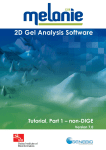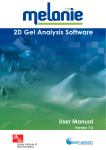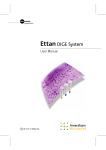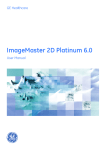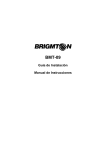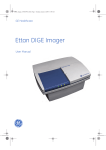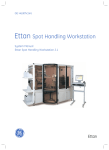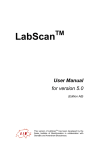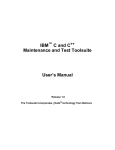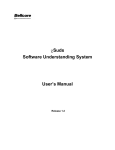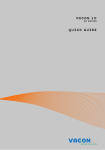Download DIGE tutorial
Transcript
Tutorial, Part 2 – DIGE Contents Contents ....................................................................................... 42 2 Melanie DIGE Tutorial.......................................................... 43 2.1 2.2 2.3 2.4 The DIGE tutorial experiment ............................................... 43 A few words about experimental design ........................... 44 Open your images ................................................................ 44 Review your images ............................................................. 48 2.4.1 2.4.2 2.4.3 2.4.4 Layout ..................................................................................48 Basic operations .................................................................48 Adjust the contrast .............................................................49 Image toolbar.....................................................................50 2.5 Create a project and match set ......................................... 52 2.5.1 2.5.2 Creating the project..........................................................53 Displaying images in a match set sheet ........................54 2.6 Detect spots ........................................................................... 55 2.6.1 2.6.2 Detecting spots ..................................................................55 Reference confirmation....................................................60 2.7 Add landmarks ..................................................................... 61 2.7.1 2.7.2 Changing layout ................................................................61 Defining landmarks ............................................................62 2.8 Match gels ............................................................................. 63 2.8.1 2.8.2 Matching gels .....................................................................63 Edit matches .......................................................................64 2.9 Create and open classes ..................................................... 67 2.10 Data analysis ......................................................................... 70 2.10.1 2.10.2 2.10.3 2.10.4 2.10.5 Class Analysis Table ...........................................................71 Class Analysis Histograms..................................................72 Identifying protein expression changes .........................73 3D view ................................................................................75 Reviewing spots ..................................................................77 2.11 Pick list ................................................................................... 78 2.11.1 2.11.2 2.11.3 2.11.4 2.11.5 Adding the pick gel to the project .................................78 Detecting spots on the pick gel ......................................81 Annotating the reference markers .................................82 Matching the pick gel .......................................................84 Generate a pick list ...........................................................86 2.12 Export tables .......................................................................... 88 Melanie DIGE Tutorial 2 2 Melanie DIGE Tutorial This tutorial will take you through the analysis of a DIGE experiment. The tutorial takes about 45 min to complete and is therefore the fastest way to start exploring Melanie on your own. More detailed and advanced information can be found in the User Manual. Nevertheless, if you have any questions or need assistance, please contact us at [email protected]. The Melanie Demo version is fully functional when analyzing the tutorial images, but it does not allow spot detection and matching on other gels. To analyze your own images, you may purchase a Full license or request a Trial license by contacting us at [email protected]. Please note that there is another tutorial for the analysis of a conventional, single stain gel electrophoresis experiment. We assume several things at this point: You are an experienced computer user. You have already successfully installed Melanie. You have knowledge of electrophoresis and staining techniques. Note: In this DIGE tutorial, a distinction is made between the terms Gel and Image. Gel is used to indicate the physical gel, whereas Image is used for the separate Cy dye images that have been obtained from the physical gel. One DIGE Gel comprises two or three DIGE Images. 2.1 The DIGE tutorial experiment The sample gels used in this tutorial come from an experiment that aims to study protein expression changes between control and treated groups of bacterial cultures. In this study, eight sample lysates were prepared; four were derived from treated bacterial cultures and four were derived from un-treated (control) bacterial cultures. Aliquots from each sample were taken and pooled to prepare a standard sample (pooled internal standard). The samples were run on four gels. The control and treated samples were alternatively labeled with Cy3 or Cy5 (dye swap) to avoid dye-bias. The standard was labeled with Cy2 and run on each gel in the experiment. A preparative gel, including reference markers, was run on the pooled sample and post-stained with a Fluor total stain to pick spots and identify them by mass spectrometry (MS). Melanie 7.0 Tutorial – Edition AB 43 2 Melanie DIGE Tutorial 2.2 A few words about experimental design Gel Cy2 Cy3 Cy5 Gel 01 Pooled internal standard Control A Treated A Gel 02 Pooled internal standard Treated B Control B Gel 03 Pooled internal standard Control C Treated C Gel 04 Pooled internal standard Treated D Control D To keep the tutorial simple and short, only six images belonging to the gels Gel 01 and Gel 02 are included in the current analysis. The complete set of 12 images, belonging to four gels, is available in the software installation folder. 2.2 A few words about experimental design For the purpose of this tutorial, only two biological replicates per treatment group are included in the analysis. This is not to be taken as a suitable number for a real-world experiment that aims to obtain meaningful results. It is essential to understand that appropriate experimental design and planning are critical if you want to draw significant conclusions from your study. We recommend the following articles to learn more on the subject: Cairns, D. A. (2011). Statistical issues in quality control of proteomic analyses: good experimental design and planning. Proteomics, 11(6), 1037-48. doi:10.1002/pmic.201000579 Karp, N. A., & Lilley, K. S. (2007). Design and analysis issues in quantitative proteomics studies. Proteomics, 7 Suppl 1, 42-50. doi:10.1002/pmic.200700683 Horgan, G. W. (2007). Sample size and replication in 2D gel electrophoresis studies. Journal of proteome research, 6(7), 2884-7. doi:10.1021/pr070114a 2.3 Open your images 1 44 The first time you launch the software, a pop-up window prompts you to enter a name for a new project. If you get this message now, ignore it by choosing Cancel. Melanie 7.0 Tutorial – Edition AB Melanie DIGE Tutorial 2 2 Instead, select File > Open in the menu. In the Open Files window, locate the Tutorials\Images folder in the Melanie installation folder (by default, C:\Program Files\GeneBio\Melanie 7\Tutorials\Images) and select the six .gel files belonging to Gel 01 and Gel 02. Click Open. 3 In the Create DIGE Gel window, make sure that the images belonging to each DIGE gel are properly grouped and click Add or Add All (if the two or three images on every line in the list correctly belong to the same DIGE gel). Note: If the file names of your DIGE images do not contain the strings Cy2, Cy3 or Cy5, you must enter the appropriate dye for each image before you will see this window. 4 For each DIGE gel, confirm or change the suggested name and click OK. Melanie 7.0 Tutorial – Edition AB 45 2 Melanie DIGE Tutorial 2.3 Open your images The software interface shows the Menu bar, the Toolbars, the Workspace window, the Image Pool sheet in the Display region and the Status bar at the bottom left. Note: The toolbars can be customized. Consult the User Manual to learn more about adding or removing buttons. Workspace Menu bar Toolbars Image Pool sheet Status bar The most common commands will be available in the toolbars. The full set of features (except Workspace-specific commands) can be accessed from the menus. The Workspace displays the open gels in the Image Pool folder. To add more gels, right-click on the Image Pool folder and select Add. The Workspace also shows the hierarchical structure (see Section 2.4) of your projects and their content (match sets, classes and gel images). 46 Melanie 7.0 Tutorial – Edition AB Melanie DIGE Tutorial 2 Using the contextual menus (right-click), the buttons, and drag and drop in the Workspace, you can display, copy, paste, move and rename files and folders. The projects Tutorial and TutorialDIGE are automatically installed to give you a quick view of what a project and detected and matched gels look like. These projects are unfinished but can be completed with the tutorial images. The Status bar displays the number of selected Gels, Spots, Matches and Annotations. Hovering the mouse over these items will also display tool tips with additional information (e.g. total number of spots, matches or annotations). The Status bar also displays the coordinates and the raw intensity value for the pixel under your cursor (when moving over a gel in the Image Pool sheet). The gel images are arranged in a tabbed sheet labeled Image Pool. The two or three images in each DIGE gel are grouped in a pane within the Image Pool sheet. 5 You can drag the border of the Workspace window to the left in order to gain space for viewing the images. Melanie 7.0 Tutorial – Edition AB 47 2 Melanie DIGE Tutorial 2.4 Review your images 2.4 Review your images 2.4.1 Layout You can change the layout of the interface in order to optimize the available space: 2.4.2 1 To arrange images within a pane, use the buttons in the top-right corner of the pane tab. 2 To arrange panes within a sheet, use the buttons in the top-right corner of the sheet. Basic operations Basic operations such as moving and zooming in on images, and defining a region of interest are carried out with the icons in the toolbar. Note: These operations will always be carried out concurrently on all images from the same DIGE gel. 48 Melanie 7.0 Tutorial – Edition AB Melanie DIGE Tutorial 2 3 To move an image, select the Move tool, click on an image and hold down the left mouse button while moving the cursor. The image changes position. Release the button at the position you want. 4 To rapidly move all gels in the current sheet to the same position with the same zoom factor, double-click on one of the gels. 5 To view the complete gel image, click on the small gray rectangle at the bottom-right of the image. The zoom factor will be automatically adjusted so that the entire image becomes visible. 6 To zoom in, select the Zoom tool, left-click repeatedly in the area of the gel where you want to zoom in. Right-click repeatedly on the gel to zoom out. 7 You can also define a zoom area: with the Zoom tool selected, place the cursor at the top left corner of the area, hold down the left mouse button, and move to the bottom right position (a red box is displayed). Release the mouse button at the end point. 8 To define a region of interest (for cropping, displaying the corresponding region in 3D, and previewing contrast adjustment), click the Region tool and place the cursor at the top left position of the area you want to define. Hold down the left mouse button and move the cursor to the bottom right position (a dashed box is displayed). Release the mouse button at the end point. Note: To simultaneously carry out the manipulations described above on all gels in the current sheet, hold down the Shift key while moving or zooming in on one gel, or defining a region. 2.4.3 Adjust the contrast To improve the display of your images and identify any saturated regions in your gels, you can adjust the contrast. Please note that contrast adjustment is only a visual tool. It does not affect the underlying raw data and will not influence the quantitation results. 9 Click Region in the toolbar. 10 Hold the Shift key and define a region in one of the images. A region of identical size appears in the other images. 11 Click on the Image Pool sheet tab to select all images. 12 Click Adjust Contrast in the toolbar. Melanie 7.0 Tutorial – Edition AB 49 2 Melanie DIGE Tutorial 2.4 Review your images Adjust the horizontal scroll bar below the histogram and/or the vertical bending parameter to modify the contrast and brightness of the images and see the effect on the regions in the selected gels. Note: You can redefine the regions of interest to look at other areas in the images. 14 To view saturated and background regions in the images, change the palette in the Colors drop-down list to Gray+Saturation. 15 To apply the contrast settings to all selected images, reset the Color drop-down list to Gray and click Apply. 16 Close the Adjust Contrast window. 2.4.4 Image toolbar The tools in the Image toolbar are convenient if gels need to be rotated, flipped, cropped, or their gray levels need to be inverted. These tools are only available as long as your images are in the Image Pool. Once you add your images to a project, they can no longer be altered. 50 Melanie 7.0 Tutorial – Edition AB Melanie DIGE Tutorial 2 Note: Any modifications made are only applied to copies of your raw/source images. The original image files are never modified by Melanie. Note: The operations are simultaneously carried out on all images of the same DIGE gel. Note: The operations are only applied to selected gels. To select a DIGE gel, click the pane tab (e.g. Gel 01). Click the sheet tab (e.g. Image Pool) to select all gels. Use the Shift or Ctrl keys to select a subset of gels. You can also select a single image by clicking on its name. To consistently crop the same region on all images: 17 Click the Region tool and define a region around the area of the gel you want to crop before further analysis. You can move the crop area by clicking inside the box and dragging it, or change the size of the area by dragging a corner or edge. 18 Identify a spot that can be recognized on all images in your experiment, and hold the Alt key while clicking on it. A dark blue circle will be centered on the spot. This so-called anchor may be located inside or outside the crop area. To change the position of the anchor, hold the Alt key and click another spot. To remove the anchor, hold the Alt key and click on the anchor. 19 Propagate the crop area to the other images in your sheet by holding the Shift key while clicking in the crop area. Adjust the Melanie 7.0 Tutorial – Edition AB 51 2 Melanie DIGE Tutorial 2.5 Create a project and match set position of the crop area in each gel by moving it so that the anchor is centered on the appropriate spot. For this tutorial, no cropping is required. When cropping is necessary, click the Crop icon in the Image toolbar. The software will ask you if you want to create new images. Answer No to replace the existing images (copies of your original files) with the cropped ones, or Yes to keep both original-sized and cropped versions of the images. 20 Since the current images do not require cropping, double-click in a gel while holding the Shift key to remove the regions from all gels. Note: It is recommended to remove any gel borders and other artifacts in the periphery in order to save disk space and memory. This will improve processing speed and optimize performance, specifically matching and normalization. You may want to retain molecular weight (MW) ladders for pI/MW calibration. 2.5 Create a project and match set With conventional single stain gel electrophoresis, all images in an experiment are not equally easy to compare, even when the gels are run in a highly controlled way. Typically, gels belonging to the same treatment (biological condition) or analytical groups (e.g. technical replicates) are easier to match than images from different groups. Melanie supports hierarchical match set designs to exploit this information and simplify and improve matching. 52 Melanie 7.0 Tutorial – Edition AB Melanie DIGE Tutorial 2 When running DIGE experiments with an Internal Standard on each gel, generally hierarchical designs are not needed, as the Internal Standard images of the different DIGE gels should enable easy gel-to-gel matching. Nevertheless, if you observe that not all gels – more precisely the Internal Standard images – are equally easy to match due to different running conditions, then you might want to try a hierarchical match design. Please refer to the Non-DIGE Tutorial or the User Manual for more information. For this tutorial and for most DIGE experiments, the match structure described below will work perfectly. Note: If your experiment contains any bad gels that you do not want to include in the analysis, you can remove them from the workspace by right-clicking on them and choosing Remove, or simply not add them to a project (see below). 2.5.1 Creating the project To create a match set with all the DIGE gels: 1 Click on the Image Pool sheet tab to select all the DIGE gels. 2 Click the Add Files to Project button in the Image toolbar. 3 In the Add Files to Project window, select <New> in the Project drop down. Enter the name DIGE Experiment as the new Project Name and click OK. 4 Click <New> in the MatchSets field, enter the name All Gels as the new MatchSet Name and click OK. The project DIGE Experiment has now been created in the Workspace and contains a match set All Gels. The DIGE gels Gel 01 and Gel 02 have been moved from the Image Pool to the Match folder in All Gels. Each gel includes the corresponding Cy2, Cy3 and Cy5 images. Melanie 7.0 Tutorial – Edition AB 53 2 Melanie DIGE Tutorial 2.5 Create a project and match set Images or gels with a red marker are used as the reference in matching. By default, the first gel (Gel 01 for this tutorial) is selected as the reference gel and all other gels will be matched to it. This matching will occur through matching of the corresponding reference images (in principle, the Internal Standard images). Note: At this point, the reference image of each gel has not yet been set. This is done when the gel is displayed for the first time (see below). The reference gel should be a representative gel with a nicely separated spot pattern and the fewest possible artifacts. For DIGE experiments with good reproducibility and including an Internal Standard on each gel, the choice of the reference gel should not be critical for the analysis. However, it is good practice to review the Internal Standard images after spot detection to decide which gel to use as the reference, before matching is carried out (see below). 5 To change the reference, drag the desired gel onto the Match folder so that it moves into the first position. Note: Changing the reference of a match set is only possible while the match set is not displayed in a sheet and as long as matching has not been carried out. Once the images have been matched, it is not possible to change the reference without losing the matches. 2.5.2 54 Displaying images in a match set sheet 6 To view the gels and images in a match set, right-click on the match set name (All Gels) and select Display. 7 For each gel, check that the correct reference image is selected and click OK. The Cy2 image is always proposed by default. For the tutorial, confirm the default Cy2 Standard images. Melanie 7.0 Tutorial – Edition AB Melanie DIGE Tutorial 2 Images are grouped in panes labeled with the gel name (Gel 01, Gel 02). The gels are placed in a sheet labeled with the match set name (All Gels). 8 Use the buttons in the top-right corners of the pane tabs and the sheet to change the layout of the interface as shown below (see Section 2.4.1). 2.6 Detect spots 2.6.1 Detecting spots For detection of DIGE gels, the DeCyderTM 2D co-detection algorithm is applied. 1 Select all gels by clicking on the match set (All Gels) sheet tab. 2 Choose Edit > Spots > Detect or click Detect in the toolbar. 3 In the DIGE Spot Detection window, enter an estimation of the Number of Spots present in the images. It is recommended that this value be overestimated to compensate for the detection of nonproteinaceous spots on the image (e.g. dust particles). Such spots Melanie 7.0 Tutorial – Edition AB 55 2 Melanie DIGE Tutorial 2.6 Detect spots can subsequently be excluded from the analysis using spot filtering. Enter 10,000 as the estimated Number of spots for the tutorial images. 4 Tick Apply to all and click OK. Spot detection can take a few minutes to complete. When it is finished, the spot outlines will be displayed on the images. 56 5 Use the Zoom tool to zoom in on a gel and note that the spot shapes are identical for the three images of the gel. 6 Choose Selection in the toolbar and click on a spot. The corresponding spots in the other images of the same gel are automatically selected. Melanie 7.0 Tutorial – Edition AB Melanie DIGE Tutorial 2 Clearly, too many spots were detected. To exclude the nonproteinaceous spots on the images, it is recommended that the spots be filtered based on the volume. More precisely, spots that have a maximum volume in the three images that is lower than a given threshold can be deleted. To exclude DIGE spots based on maximum volume: 7 Choose Tools > Options from the menu, go to the Quantification tab and make sure the box Compute area and volume in mm2 is ticked. Note that spot filtering will work equally well with this option deselected (area and volume computed in pixels), but the volume cutoff used below will be expressed in different units and this could lead to confusion. Click OK. 8 Choose Reports > Spot Table to display a table with information about each spot. 9 Click Select By Value in the toolbar of the table. 10 In the Select By Value window, select Vol in the displayed list. Make sure the >= box is checked and enter a value to be used as the cutoff for the volume. A value of 300 generally works well. Deselect the <= box and click OK. All spots with a volume higher than the given threshold are selected, together with their matched spots (which may have volumes that are smaller than the threshold). These are the spots that will be kept. Zoom in on the images to verify that the deselected, red spots are not real protein spots. If some of them are, filter again with a lower cutoff. Melanie 7.0 Tutorial – Edition AB 57 2 Melanie DIGE Tutorial 2.6 Detect spots 11 Choose Select > Spots > Inverse Selection. The new selection includes all spots for which the maximum volume in any of the three DIGE images is lower than the given threshold. 12 Choose Edit > Spots > Delete or click Delete in the toolbar to permanently delete the selected spots from your DIGE gels. Click Yes when asked to confirm the deletion. 13 Close the Spot Table. 14 To view the entire images, hold Shift and click on the small gray rectangle at the bottom right of one of the images. 58 Melanie 7.0 Tutorial – Edition AB Melanie DIGE Tutorial 2 Note: Except for deleting selected spots as described above, no spot editing is allowed on DIGE images. You may want to delete spots on the gel borders or on gel artifacts (e.g. broken gel). To do so, you must select the spots first: 15 Click Select in the toolbar and click on a spot. Once selected, the spot is highlighted in green. 16 To select all spots in an area, place the cursor at the top left position of the desired area, hold down the left mouse button, and then drag the cursor to the bottom right position. All spots in the designated area are selected. 17 To select more than one spot, select the first one and then hold down the Shift or Ctrl key while clicking on additional spots. 18 To select all spots in all images, make sure all gels are selected by clicking on the sheet tab, and then choose Select > Spots > All or use the Shift+A keyboard shortcut. 19 To deselect a spot, hold down the Shift or Ctrl key while clicking on it. 20 To deselect all spots, click anywhere in the image (not on a spot). Melanie 7.0 Tutorial – Edition AB 59 2 Melanie DIGE Tutorial 2.6 Detect spots 2.6.2 Reference confirmation Before continuing with the matching process, it is a good idea to carefully review your gels to confirm the matching reference. Reference gels for matching should have nicely separated spots, no gel distortions, a minimum number of streaks, and – all other things being equal – the highest number of detected spots (real spots, not artifacts). 21 To quickly see the number of spots detected on each gel, hover over the Spots item in the Status bar at the bottom-left of the program window. For each image, the number of currently selected spots and the total number of spots is shown. The tutorial gels have similar separation quality. However, Gel 01 has more spots and can therefore be kept as the reference. At this point, you can still change the reference gel in the Workspace, based on the spot detection results. To be able to do so, you must close the sheet first. Now drag the chosen gel onto the Match folder so that it is placed in the first position. It will have a red marker. Display the match set again to continue working, by right-clicking on the match set name and selecting Display. 22 To maximize the available space for viewing gels, click Auto Hide at the top right of the Workspace window to minimize the Workspace. 60 Melanie 7.0 Tutorial – Edition AB Melanie DIGE Tutorial 2 2.7 Add landmarks 2.7.1 Changing layout The images of the same DIGE gel are automatically matched. Therefore, it is only necessary to match the Internal Standard images of the different gels to find the correspondences, i.e. matches, between all images. Change the layout to focus on the Cy2 Standard images: 1 Set the layout of the pane tabs to Stacked. 2 Set the layout of the sheet to Tiled. By default, the Cy2 Standard image appears on top of the stack in each gel pane. 3 To switch between images in a gel stack, click repeatedly on the right-most image tab at the bottom of the gel pane. The name of the visible image always appears on top of the pane. Continue clicking until the Cy2 Standard image is again on top (visible). Melanie 7.0 Tutorial – Edition AB 61 2 Melanie DIGE Tutorial 2.7 Add landmarks 2.7.2 Defining landmarks When gels are distorted or relatively different, you may need to help the matching process by specifying a few landmarks. Landmarks are points that relate corresponding spots in each of the gels to be matched. Try to match your gels with a single landmark or, if possible, none at all. If the matching results are not satisfactory, you can repeat the automatic matching procedure using additional landmarks. The following rules should be considered when defining landmarks: Keep the number of landmarks to a minimum. Only define landmarks on clearly corresponding spots. Protein variants should definitely not be used as landmarks. Landmarks should be placed on small, sharp spots rather than on large, diffuse ones (to reduce the error in the position). Landmarks essentially correct global deformations of gels. Therefore, it is recommended not to put landmarks on spots in locally distorted regions. Rather place landmarks around such regions. 4 On the reference gel, zoom in on a region with a clearly recognizable spot pattern and move the other gels to show the same area. 5 Click Landmark in the toolbar. 6 Position the cursor over a known, well-defined spot in the reference gel (Gel 01 Cy2 Standard) and click. A “Validated” landmark symbol (bold orange circle) appears on the spot. In the next image (Gel 02 Cy2 Standard), drag the “Non-validated” landmark symbol (green circle with orange plus sign) onto the corresponding spot. Once the mouse button is released, the landmark is validated and identified with a number. If you put the landmark on the wrong spot, just drag it to the right spot. 62 Melanie 7.0 Tutorial – Edition AB Melanie DIGE Tutorial 2 For the tutorial gels, only one landmark needs to be defined, and only one gel needs to be matched. On your own experiments, repeat this process for all gels and possibly for additional landmarks. 2.8 Match gels 2.8.1 Matching gels 1 Select all gels by clicking on the sheet tab. 2 Choose Edit > Matches > Match Gels or click Match Gels in the toolbar. 3 When the process is completed, the number of matches created appears. Click OK. The match vectors are displayed in blue. Vectors link the spot in a gel with the corresponding spot in the Sheet Display Reference image (imagine that the reference lies below). This reference image should Melanie 7.0 Tutorial – Edition AB 63 2 Melanie DIGE Tutorial 2.8 Match gels not be mistaken for the match reference and can be changed with View > Sheet > Set Reference. In general, it is most intuitive to keep the default global match reference as the Sheet Display Reference. If the matching performed well, the match vectors will point in the same direction and have the same magnitude. If there is a mismatch, the vector has a different length and/or orientation. When a gel is moved, the vectors become longer. Select Move in the toolbar and double-click in the gel to recenter all the images, including the reference, to the same position and therefore minimize the match vectors. A spot with a blue triangle means that the corresponding position in the Sheet Display Reference lies outside the visible area. 2.8.2 Edit matches To review matching: 64 4 Use the Select tool to click on a spot. The spot and any matched spots are highlighted in green. 5 Choose Select > Matches > All to highlight all matched spots. The matching of any red spots should be scrutinized. Melanie 7.0 Tutorial – Edition AB Melanie DIGE Tutorial 2 Match editing can be done at any time during data analysis. Even if it is good practice to quickly review the match results at this point in order to rematch with additional landmarks if necessary, it is more efficient and convenient to edit matches during the results review process. To edit matches: 6 To easily locate the examples in the tutorial images, select View > Global > Show Overview from the menu. In the small view of the entire gel at the bottom right of each image, you will see a green square that localizes the visible area of the gel. In the example above, the spot in Gel 02 has been split. Due to the resulting ambiguity, none of the two spots was matched with the single spot in Gel 01. You can manually add a single or a multiple match to allow spot comparison. To add a single match: 7 Select the spot in the reference gel. 8 Hold the Shift or Ctrl key and select one of the two spots (resulting from the spot splitting) in the second gel. If you have more gels, Melanie 7.0 Tutorial – Edition AB 65 2 Melanie DIGE Tutorial 2.8 Match gels continue holding the Shift or Ctrl key while selecting corresponding spots in the other gels. Choose Edit > Matches > Add Match or click Add Match in the toolbar. All of the selected spots are now matched. Note: It is important to understand that for DIGE experiments using an Internal Standard and calculating the Volume Ratio as quantification value (volume of current image spot/volume of DIGE reference image spot), it does not really matter which of the two spots in Gel 02 is selected for comparison with the spot in Gel 01. The Volume Ratios of the two spots resulting from the spot splitting will generally be very similar and can be directly compared with the Volume Ratio of the single spot in Gel 01. Alternatively, you can create a multiple match: 10 Select the spot in the reference gel. 11 Hold the Shift or Ctrl key and select the two corresponding spots in the second gel. If you have more gels, continue holding the Shift or Ctrl key while selecting all corresponding spots in the other gels. Choose Edit > Matches > Add Match or click Add Match in the toolbar. All of the selected spots are now matched. 66 Melanie 7.0 Tutorial – Edition AB Melanie DIGE Tutorial 2 In the analysis, the quantitation value of the single spot in Gel 01 (e.g. on Gel 01 Cy3 Control) will be compared with the summed quantitation values of the two spots in Gel 02 (e.g. on Gel 02 Cy3 Treated). 13 To delete matches, select matched spots and choose Edit > Matches > Delete Match or click Delete Match in the toolbar. 2.9 Create and open classes To analyze protein expression variations between different conditions (e.g. treatment groups), it is necessary to define classes. A class is a set of gels that includes all samples from a given condition (e.g. control group or treatment group). 1 Open the Workspace window by clicking on its tab at the left side of the program window and click the Auto Hide icon to pin it so that it does not close automatically. Melanie 7.0 Tutorial – Edition AB 67 2 Melanie DIGE Tutorial 2.9 Create and open classes 2 Hold the Ctrl key while selecting the images Gel 01 Cy3 Control and Gel 02 Cy5 Control in the Match folder. 3 Right-click on the selection and choose Add in Class. 4 In the Add Gels in Class window, enter Control as the name for a new class and click OK. You can use an alternative approach to create the Treated class: 68 5 Hold the Ctrl key while selecting the images Gel 01 Cy5 Treated and Gel 02 Cy3 Treated in the Match folder. 6 Drag the selection onto the Classes folder. 7 In the Create Class window, enter Treated as the Name and click OK. Melanie 7.0 Tutorial – Edition AB Melanie DIGE Tutorial 2 Repeat these steps until all classes are created. You can create as many classes as required. Imagine that you have both Male and Female subjects in the Treated and Control groups. You could create the classes Control_Male, Control_Female, Treated_Male and Treated_Female to compare the four conditions. You could also create and compare classes Control and Treated to study the effect of the treatment, or classes Male and Female to investigate the effect of the gender. 8 Hold the Ctrl key to select the classes to be compared (Control and Treated). 9 To open the images in a class sheet, right-click and select Display. Melanie 7.0 Tutorial – Edition AB 69 2 Melanie DIGE Tutorial 2.10 Data analysis A new sheet with the name Control - Treated opens in the display area. You must be in such a Class sheet (indicated by the icon and the tooltip when hovering over the sheet tab) to access the reports that compare different conditions (Class Analysis Tables and Histograms). 10 Hide the Workspace by clicking on Auto Hide at the top right of the window. 11 Choose View > Global > Show Overview to hide the small image views. 12 Rearrange the Pane layouts so that the images are displayed in One Column. 2.10 Data analysis By default, Melanie uses the Volume Ratio for DIGE spot quantification. This can be changed by choosing Tools > Options and going to the Quantification tab. Please refer to the User Manual for further details. The default Volume Ratio is highly recommended for this tutorial experiment and for most DIGE data sets. 70 Melanie 7.0 Tutorial – Edition AB Melanie DIGE Tutorial 2 2.10.1 Class Analysis Table Differential analysis between populations of gels, i.e. classes, is essentially based on the values found in the Class Analysis Table. 1 Choose Reports > Analyse Classes > Table. The title of the table indicates that the Central tendency and Dispersion values calculated for each class correspond to the Mean and M.S.D. (Mean Squared Deviation), respectively. Choose Center in the Class Analysis Table drop down list to display the Central tendency for each class (columns Control and Treated). When choosing Dispersion in the list, the columns Control and Treated show the Dispersion for the corresponding class. 2 Click Statistics in the Class Analysis Table toolbar to change the statistical values displayed. Note: The sliders in the Classes Statistics window allow you to remove a percentage of outliers for the calculation of the Central tendency and the Dispersion. As explained in the User Manual, this can be used in combination with the other options to compute statistics that are less sensitive to extreme values (outliers). Keep in mind that this is only useful for experiments with sufficiently large sample sizes. By default, no outliers are excluded, and the Mean and Mean squared deviation are calculated. Note: Only two classes can be compared when using the MannWhitney and Kolmogorov-Smirnov tests (indicated for data with nonnormal distributions). If you have more than two classes in a Class sheet, Melanie 7.0 Tutorial – Edition AB 71 2 Melanie DIGE Tutorial 2.10 Data analysis you can select the two classes to be used for the calculation of the Mann-Whitney and Kolmogorov-Smirnov statistics in the section Classes for Statistical Tests. This choice is not taken into account for the ANOVA test, which allows the comparison of more than two classes. 3 Keep the default statistics (Mean, Mean squared deviation, both sliders set at 100%) and click OK. By default, columns Control and Treated in the Class Analysis Table display the Center, i.e. mean value (including 100% of spots) for the corresponding class. The Max column lists the highest of these values, whereas the Fold column shows the fold-change between the classes. Please note that when you compare three or more classes, the Fold column displays the fold-change between the class with the lowest mean value and the class with the highest mean value. 2.10.2 Class Analysis Histograms 4 For a visual representation of these values, choose Reports > Analyse Classes > Histograms. Each histogram displays, for a given spot, the quantification values in the different gels as orange bars. To see which gel corresponds to which letter, click the Settings button in the Class Analysis Histograms toolbar and select Show Labels. Alternatively, move your cursor over a 72 Melanie 7.0 Tutorial – Edition AB Melanie DIGE Tutorial 2 letter to view the gel name. The quantification values for different classes are separated by gray vertical lines. The blue horizontal lines in the histograms represent the mean values for each class. The red lines delimit the dispersion intervals defined by [Mean value - M.S.D, Mean value + M.S.D]. 2.10.3 Identifying protein expression changes Generally, you will only want to review the most interesting protein spots. You can do this for instance by limiting the analysis to spots that: show statistically significant expression variations between groups (e.g. ANOVA probabilities < 0.01) show differences of a certain magnitude (e.g. Fold changes > 2) To select all spots that satisfy such criteria: 5 Click Settings in the toolbar of the Class Analysis table. 6 Tick the Anova box and click OK to display a column with the probabilities for the ANOVA test in the Class Analysis Table. 7 Click Select By Value in the toolbar of the Class Analysis Table. 8 In the Select By Value window, select Anova in the displayed list. Make sure the <= box is checked and enter a value of 0.01 as the cutoff. Deselect the >= box and click OK. All spots that show statistically significant expression variation between Control and Treated, based on the selected criterion, are now selected. 9 Click Create Spot Set in the Class Analysis Table toolbar. 10 In the Create Spot Set window, enter Anova < 0.01 as the name of the new spot set and click OK. 11 Again click Select By Value in the toolbar of the Class Analysis Table. Melanie 7.0 Tutorial – Edition AB 73 2 Melanie DIGE Tutorial 2.10 Data analysis 12 In the Select By Value window, select Fold in the displayed list. Check the >= box and enter a value of 2. Deselect the <= box and click OK. All spots that show a fold change larger than or equal to a factor of 2 between the Control and Treated groups are now selected. 13 Click Create Spot Set in the Class Analysis Table toolbar. 14 In the Create Spot Set window, enter Fold > 2 as the name of the new spot set and click OK. You have created two new columns in the Class Analysis Table. Double-click on the right border of their headers to resize the columns so that their name becomes visible. Spots that belong to a spot set have the box in the corresponding column checked. You can combine spot sets to select spots that satisfy both criteria: 15 Select Edit > Spot Sets > Combine in the menu. 16 In the Inputs lists, select the spot sets Anova < 0.01 and Fold > 2, make sure And is selected as the Operator, and enter the name Verify in the Output field in order to create a spot set with that name. Click OK. A new spot set Verify is created. 74 Melanie 7.0 Tutorial – Edition AB Melanie DIGE Tutorial 2 17 Click twice on the header of the Verify column in the Class Analysis Table to put all spots belonging to this spot set at the top of the table. 18 Scroll to the top of the table and select the first spot in the list. Matched spots will be automatically selected in all images. 2.10.4 3D view To review the spots that you have just selected, it is convenient to have the 3D View displayed in addition to the Class Analysis Table and Histograms. 19 Choose Reports > 3D View in the menu to visualize the threedimensional views for the selected spot in all the images. 20 To rotate the images in the 3D View, left-click and move your mouse. 21 Use the scroll wheel of your mouse to zoom in or out. Note: You can explore the 3D views in more detail with the other options in the 3D View toolbar. The 3D View is displayed in the same window as the Class Analysis Histograms. 22 To move the 3D View to a separate window, click on the 3D View tab at the bottom of the window and drag towards the center of the gel display area. Blue arrows will appear. By moving the cursor over the arrows, a shaded blue box will show where the window will appear once the left mouse button is released. Release the mouse button over the arrow pointing to the right. The 3D View window will be placed to the right of the gel display area. Melanie 7.0 Tutorial – Edition AB 75 2 Melanie DIGE Tutorial 2.10 Data analysis 23 Similarly, click the Class Analysis Histograms title and drag the histograms to the right of the Class Analysis Table. 24 Resize the windows to obtain the layout below. 76 Melanie 7.0 Tutorial – Edition AB Melanie DIGE Tutorial 2 2.10.5 Reviewing spots You can now decide, for each spot marked Verify whether you want to include or exclude it for further analysis (e.g. by mass spectroscopy). 25 As shown in the image above, the first spot in the Class Analysis Table is clearly up-regulated in the Treated group compared to the Control group. 26 Click Create Spot Set in the Class Analysis Table toolbar. 27 In the Create Spot Set window, enter Include as the name of the new spot set and click OK. 28 Again click Create Spot Set in the Class Analysis Table toolbar. 29 In the Create Spot Set window, enter Exclude as the name of the new spot set and click OK. You have created two new columns in the Class Analysis Table. Double-click on the right border of their headers to resize the columns. You can now use these spot sets to include or exclude spots from the analysis. Melanie 7.0 Tutorial – Edition AB 77 2 Melanie DIGE Tutorial 2.11 Pick list 30 Deselect the Exclude box for the first spot (this spot automatically became part of the Exclude spot set because it was selected when the spot set was created). 31 Use the down arrow key to move to the next spot in the table. Note: Using the up or down arrow keys to move from one spot to another in a table will only work if the table is active (has a darker title bar). To activate a table, just click on its title. 32 Use the information in the 2D and 3D views, as well as the Class Analysis Table and Histograms, to decide if a spot should be included or excluded in the analysis. Tick the corresponding box (Include or Exclude) while working down the list. You can stop reviewing when spots no longer satisfy the fixed criteria (i.e. belong to spot set Verify). Note: While reviewing your spots in this way, you can edit matches if necessary. The quantification values are automatically recalculated. When spots are sorted based on a numerical value (e.g. Anova, Fold) rather than a spot set, this means that spots can move up or down in the list. When this happens, just scroll back to the first non-reviewed spot after ticking Include or Exclude. Note: Do not spend time editing ambiguous or uninteresting spots (e.g. saturated spots, spots in streaks, background artifacts). Just click to Exclude them. 33 Close the Control - Treated sheet when you have finished reviewing spots. 2.11 Pick list In the current DIGE experiment, a preparative gel was run on the pooled sample and post-stained with a Fluor total stain to allow spot picking with the GE Healthcare Ettan spot picker and subsequent protein identification by mass spectrometry (MS). To create a pick list for this particular gel, spots must first be detected, the reference markers annotated, the pick gel matched to the analyzed DIGE images, and finally, the spots of interest must be selected. 2.11.1 Adding the pick gel to the project 1 78 Click the Workspace tab and pin the Workspace window by clicking on the Auto Hide icon in the top-right corner. Melanie 7.0 Tutorial – Edition AB Melanie DIGE Tutorial 2 2 Select File > Open in the menu. In the Open Files window, locate the Tutorials\Images folder in the Melanie installation folder (by default, C:\Program Files\GeneBio\Melanie 7\Tutorials\Images) and select the file Pick.gel. Click Open. 3 In the Gel Properties window, select Cy2, Cy3 or Cy5 if you want the pick image to be detected with the DeCyder 2D co-detection algorithm. If you used a fluorescent stain, this option will generally give you a spot pattern and spot shapes that are very similar to those on the analytical DIGE gels and this will facilitate matching. Enter any other stain if you prefer to detect the pick image with the default Melanie algorithm. For this tutorial, select Cy2 from the list and click OK. 4 In the Create DIGE Gel window, click on Add. 5 Enter PickGel as the DIGE Name and click OK. 6 Adjust the contrast of the image as described in Section 2.4.3. When finished, close the Adjust Contrast window. Note: You will see two big black dots on the Pick image. These are the two reference markers that will be used by the GE Healthcare Ettan spot picker for the calibration of the coordinates between the analyzed gel image and the actual gel located on the spot picker. 7 Select PickGel in the Image Pool folder in the Workspace and drag it onto the match set All Gels. PickGel is added as the third DIGE gel in the All Gels match set. 8 Select All Gels in the Workspace, right-click and choose Display to show the match set in a sheet. 9 When asked to choose the Reference for match set PickGel, click OK to accept the unique image in the match set, i.e. Pick. Melanie 7.0 Tutorial – Edition AB 79 2 Melanie DIGE Tutorial 2.11 Pick list 10 Hide the Workspace by clicking on Auto Hide at the top right of the window. 11 Select the panes Gel 01 and Gel 02 and change their layout to Stacked. Change the layout of the sheet All Gels to One Row. 12 To view the entire images, hold Shift and click on the small gray rectangle at the bottom right of one of the images. Gel 01, Gel 02 and PickGel are displayed next to each other, with the Internal Standard images of the DIGE gels on top (visible). 80 Melanie 7.0 Tutorial – Edition AB Melanie DIGE Tutorial 2 2.11.2 Detecting spots on the pick gel 13 Select PickGel only, by clicking on the pane header. 14 Choose Edit > Spots > Detect or click Detect in the toolbar. 15 Enter 10,000 as the estimated Number of spots and click OK. Once detection is finished, you must exclude the non-proteinaceous spots based on maximum volume: 16 Choose Reports > Spot Table to display the Spot Table. 17 Click Select By Value in the toolbar of the table. 18 In the Select By Value window, select Vol in the displayed list. Make sure the >= box is checked and enter a value to be used as the cutoff for the volume. A value of 300 works well for this pick gel. Deselect the <= box and click OK. All spots with a volume higher than the given threshold are selected. Zoom in on the images to verify that the deselected, red spots are not real protein spots. If some of them were, you could filter again with a lower cutoff. Melanie 7.0 Tutorial – Edition AB 81 2 Melanie DIGE Tutorial 2.11 Pick list 19 Choose Select > Spots > Inverse Selection. Make sure that only nonproteinaceous spots on the image Pick are selected (and no spots on Gel 01 or Gel 02). 20 Choose Edit > Spots > Delete or click Delete in the toolbar to permanently delete the selected spots from PickGel. Click Yes when asked to confirm the deletion. 21 Close the Spot Table. 2.11.3 Annotating the reference markers You will notice that many small spots were detected on the two reference markers. It is recommended to delete these spots so that they do not interfere with the annotation of the markers. 22 Zoom in on the image to better see the left reference marker. 23 Click Selection in the toolbar and select the spots on the markers, as described in section 2.6.1. Delete the spots by clicking Delete in the toolbar. 24 While still having the Selection tool activated, double-click on the center of the left marker spot. 82 Melanie 7.0 Tutorial – Edition AB Melanie DIGE Tutorial 2 25 In the Create Annotation by Click window, choose the Comment category and click OK. 26 Enter IR1 as the label text and click OK. An annotation of category Comment and with label text IR1 is created. If it is not in the center of the reference marker, you can move it to the appropriate position. Do this by clicking on its basis (cross) and holding down the left mouse button while dragging the annotation to its new position. You can zoom in on the marker while doing this, to improve the precision on the location. 27 Repeat the steps 22 to 26 for the reference marker on the right, entering the label text IR2 this time. Melanie 7.0 Tutorial – Edition AB 83 2 Melanie DIGE Tutorial 2.11 Pick list 2.11.4 Matching the pick gel Zoom in on an area with a clearly corresponding spot pattern in all three gels in order to define a landmark that will facilitate matching between PickGel and Gel 01(the reference of the match set All Gels). In this tutorial, we will use the same landmark as the one selected previously to match Gel 02 with Gel 01. But any other small, recognizable spot can be chosen as a landmark. 28 Click Landmark in the toolbar. Orange circles will appear on the spots that were previously used as landmarks. 29 Click on the landmark labeled 1. A “Non-validated” landmark symbol appears on the image Pick. Drag this symbol onto the correct spot to validate the landmark (see Section 2.7.2). It may be necessary to move the Pick image a little to see the destination spot. When releasing the mouse button, the validated landmark is identified with a number (1). 84 Melanie 7.0 Tutorial – Edition AB Melanie DIGE Tutorial 2 30 Select Gel 01 and PickGel by clicking on their pane headers while holding the Ctrl key. 31 Click Match Gels in the toolbar. 32 When the process is completed, the number of matches created appears. Click OK. Review the match results as indicated in Section 2.8.2. From the small vectors and correct spot correspondences in the upper part of your image, you can conclude that the matching worked quite well in a large part of the images. Nevertheless, there are many missing matches and some doubtful matches in the lower molecular weight region (bottom third of the image). This can partly be explained by dye shifts that cause some low molecular weight proteins to appear with multiple peaks in the DIGE images. If you want to pick spots in this region, you must define additional landmarks in this area and rematch Gels 01 and PickGel. Melanie 7.0 Tutorial – Edition AB 85 2 Melanie DIGE Tutorial 2.11 Pick list 2.11.5 Generate a pick list In principle, you will want to pick all the spots of interest, i.e. those that you previously added to the spot set Include. When the images are properly matched, selecting the spot set Include will automatically select all corresponding spots on the Pick image. Nevertheless, it is recommended to review the Include selection to make sure that you will pick the right spots. 33 Choose Reports > Analyse Gels > Table. In addition to the quantification value of each spot (row) for each image (columns with the image names), the Gel Analysis Table also shows the spot sets. 34 Click twice on the header of the Include column in the table to put all spots belonging to this spot set at the top of the table. 35 Scroll to the top of the table and select the first spot in the list. Matched spots will be automatically selected in all images. 36 Verify that the selected spot in the Pick image effectively corresponds to the spot to be picked. If no spot is selected in the Pick image, or if the wrong spot is matched, you can still edit the matches at this point. 86 Melanie 7.0 Tutorial – Edition AB Melanie DIGE Tutorial 2 Note: If no spot was detected in the corresponding position on the Pick image, you will not be able to pick the spot. This is because it is not allowed to add spots on a gel detected with the DeCyder 2D codetection algorithm, though a spot is needed for picking. If this happens for too many spots, you can try to detect the pick gel as a single-stain image (select any stain other than Cy2, Cy3 or Cy5). For such images, it is allowed to manually add spots that you can then match with the spots in the analytical gels. Once all spots belonging to spot set Include have been reviewed, you can generate a pick list for the GE Healthcare Ettan spot picker: 37 Choose Select > Spot Sets. 38 Select Include in the Select Spot Set window and click OK. All spots belonging to the set Include are selected. 39 Select the image Pick by clicking on its name. 40 Choose File > Export > Spots to Picker > GE Healthcare Ettan. 41 Browse to select a location, enter a File name and click Save. Note: Procedures for other spot excision robots vary. Consult the User Manual for more details about the different spot picker formats. Melanie 7.0 Tutorial – Edition AB 87 2 Melanie DIGE Tutorial 2.12 Export tables Note: If your spot picker is not in the list of available spot excision robots, try exporting a Spot Table by choosing Report > Spot Table, and edit the generated file as necessary. 2.12 Export tables 88 1 To export the data in a table (e.g. Class Analysis Table, Gel Analysis Table, Spot Table) in text, Excel or XML formats for use in other software, click Save in the table toolbar. 2 In the Save Table window, indicate whether you want to export all rows or only the selected ones. 3 Browse to select a location and enter a File Name. Select the type of file from the Save as type drop-down list and click Save. Melanie 7.0 Tutorial – Edition AB This version of Melanie has been developed by the Swiss Institute of Bioinformatics in collaboration with Geneva Bioinformatics (GeneBio) SA and GE Healthcare. Melanie is powering the ImageMaster 2D Platinum gel analysis software sold by GE Healthcare. All intellectual property rights on this Tutorial, as well as on Melanie, belong to the Swiss Institute of Bioinformatics. GeneBio owns the worldwide exclusive distribution rights on this intellectual property. No part of this Tutorial may be reproduced or transmitted in any form or by any means, electronic or mechanical, including photocopy, recording or any information storage or retrieval system, without permission in writing from the Swiss Institute of Bioinformatics or GeneBio. © 2014 Swiss Institute of Bioinformatics - All rights reserved. First published March 2012 Swiss Institute of Bioinformatics CMU, 1 Rue Michel-Servet, CH-1211 Geneva, Switzerland Melanie provides access to several databases on the Internet. It is the responsibility of the user to acquire the database licenses, if needed. In particular, the PROSITE and SWISS-2DPAGE databases are copyright and all commercial users of these databases are required to purchase a database license from GeneBio. Please contact GeneBio at [email protected] for more information. Geneva Bioinformatics (GeneBio) SA c/o Swiss Institute of Bioinformatics, CMU - 1 rue Michel Servet, 1211 Geneva, Switzerland Melanie uses the DeCyder co-detection algorithm. © 2008 General Electric Company - All rights reserved. Melanie uses the TIFF library. © 1988–1999 Sam Leffler and 1991–1999 Silicon Graphics, Inc – All rights reserved. Melanie uses software developed by the Apache Software Foundation (http://www.apache.org). © 1999–2007 The Apache Software Foundation – All rights reserved. www.genebio.com Cy, CyDye, DeCyder, Ettan, ImageMaster, Immobiline and ImageScanner are trademarks of GE Healthcare companies. GE is a trademark of General Electric Company. Geneva Bioinformatics (GeneBio) SA All third party trademarks are the property of their respective owners. c/o Swiss Institute of Bioinformatics CMU - 1, rue Michel Servet 1211 Geneva Switzerland All goods and services are sold subject to the terms and conditions of the license agreement communicated to you by GeneBio. GeneBio reserves the right, subject to any regulatory and contractual approval, if required, to make changes in specifications and features shown herein, or discontinue the product described at any time without notice or obligation. Contact GeneBio at [email protected] for the most current information. Melanie 7.0 Tutorial – Edition AB


















































